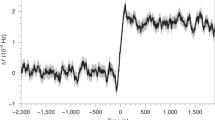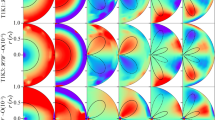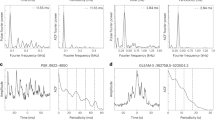Abstract
PULSAR rotation rates generally decrease steadily owing to external electromagnetic braking torques, but occasionally show sudden increases ('glitches') followed by gradual recoveries that may last days or years. These events are thought to be consequences of angular momentum transfer between a solid crust, which rotates at the measured pulsar periodicity, and a more rapidly rotating "loose' component of the neutron star interior. Sudden braking of the differential rotation between the two components will cause a glitch1, and the subsequent re-establishment of rotational equilibrium between the two components represents the recovery2. Earlier studies, using particular models for the coupling between crust and interior, showed that the loose component carries ∼2.8% and ≳1% of the total moment of inertia of the Vela pulsar3 and PSR 1737 – 30 (ref. 4) respectively. Here, we analyse post-glitch recovery in four pulsars, and deduce that the loose component carries at least 0.8% of the total moment of inertia, independent of the form of the coupling. In the context of the 'vortex creep' model of recovery, in which the loose component is the inner-crust neutron superfluid2'5–7, the constraint on the moment of inertia rules out equations of state that are soft at high densities.
This is a preview of subscription content, access via your institution
Access options
Subscribe to this journal
Receive 51 print issues and online access
$199.00 per year
only $3.90 per issue
Buy this article
- Purchase on Springer Link
- Instant access to full article PDF
Prices may be subject to local taxes which are calculated during checkout
Similar content being viewed by others
References
Anderson, P. W. & Itoh, N. Nature 256, 25–27 (1975).
Alpar, M. A., Anderson, P. W., Pines, D. & Shaham, J. Astrophys. J. 276, 325–334 (1984).
Pines, D. & Alpar, M. A. in Structure and Evolution of Neutron Stars (eds Pines, D., Tamagaki, R. & Tsuruta, S.) (New York, Addison-Wesley, in the press).
Michel, F. C., Bland Hawthorn, J. & Lyne, A. G. Mon. Not. R. astr. Soc. 246, 624–627 (1990).
Link, B. & Epstein, R. I. Astrophys. J. 373, 592–603 (1991).
Link, B., Epstein, R. I. & Baym, G. Astrophys. J. (in the press).
Epstein, R. I. & Baym, G. Astrophys. J. 328, 680–690 (1988).
Alpar, M. A., Langer, S. A. & Sauls, J. A. Astrophys. J. 282, 533–541 (1985).
Ainsworth, T. L., Wambach, J. & Pines, D. Phys. Lett. B222, 173–178 (1989).
Chen, J. M. C., Clark, J. W., Krotscheck, E. & Smith, R. A. Nucl. Phys. A451, 509–540 (1986).
Baym, G., Pethick, C. & Sutherland, P. Astrophys. J. 170, 299–317 (1971).
Pandharipande, V. R. Nucl. Phys. A174, 641–656 (1971).
Friedman, B. & Pandharipande, V. R. Nucl. Phys. A361, 502–520 (1981).
Bethe, H. A. & Johnson M. Nucl. Phys. A230, 1–58 (1976).
Cohen, J. M., Langer, W. D., Rosen, L. C. & Cameron, A. G. W. Astrophys. Space Sci. 6, 228–239 (1970).
Pandharipande, V. R. & Smith, R. A. Phys. Lett. B59, 15–18 (1975).
Wolszczan, A. Nature 350, 688–690 (1991).
Wiringa, R. B., Fiks, V. & Fabrocini, A. Phys. Rev. C38, 1010–1037 (1988).
Brown, G. E. Nature 336, 519–520 (1988).
Brown, G. E., Bruenn, S. W. & Wheeler, J. C. Comments Astrophys. (in the press).
Lohsen, E. H. G. Astr. Astrophys. Suppl. 44, 1–14 (1981).
Lyne, A. G. & Pritchard, R. S. Mon. Not. R. astr. Soc. 229, 223–226 (1987).
Cordes, J. M., Downs, G. S. & Krause-Polstorff, J. Astrophys. J. 330, 847–869 (1988).
McCulloch, P. M., Klekociuk, A. R., Hamilton, P. A. & Royle, G. W. R. Aust. J. Phys. 40, 725–730 (1987).
McCulloch, P. M., Hamilton, P. A., McConnell, D. & King, E. A. Nature 346, 822–824 (1990).
Lyne, A. G. Nature 326, 569–571 (1987).
Downs, G. S. Astrophys. J. 257, L67–L70 (1982).
Author information
Authors and Affiliations
Rights and permissions
About this article
Cite this article
Link, B., Epstein, R. & Van Riper, K. Pulsar glitches as probes of neutron star interiors. Nature 359, 616–618 (1992). https://doi.org/10.1038/359616a0
Received:
Accepted:
Issue Date:
DOI: https://doi.org/10.1038/359616a0
This article is cited by
-
Precision pulsar timing with the ORT and the GMRT and its applications in pulsar astrophysics
Journal of Astrophysics and Astronomy (2018)
-
An anti-glitch in a magnetar
Nature (2013)
Comments
By submitting a comment you agree to abide by our Terms and Community Guidelines. If you find something abusive or that does not comply with our terms or guidelines please flag it as inappropriate.



